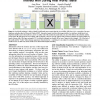Free Online Productivity Tools
i2Speak
i2Symbol
i2OCR
iTex2Img
iWeb2Print
iWeb2Shot
i2Type
iPdf2Split
iPdf2Merge
i2Bopomofo
i2Arabic
i2Style
i2Image
i2PDF
iLatex2Rtf
Sci2ools
IUI
2010
ACM
2010
ACM
Automatically identifying targets users interact with during real world tasks
Information about the location and size of the targets that users interact with in real world settings can enable new innovations in human performance assessment and software usability analysis. Accessibility APIs provide some information about the size and location of targets. However this information is incomplete because it does not support all targets found in modern interfaces and the reported sizes can be inaccurate. These accessibility APIs access the size and location of targets through low-level hooks to the operating system or an application. We have developed an alternative solution for target identification that leverages visual affordances in the interface, and the visual cues produced as users interact with targets. We have used our novel target identification technique in a hybrid solution that combines machine learning, computer vision, and accessibility API data to find the size and location of targets users select with 89% accuracy. Our hybrid approach is superior to...
| Added | 17 May 2010 |
| Updated | 17 May 2010 |
| Type | Conference |
| Year | 2010 |
| Where | IUI |
| Authors | Amy Hurst, Scott E. Hudson, Jennifer Mankoff |
Comments (0)

